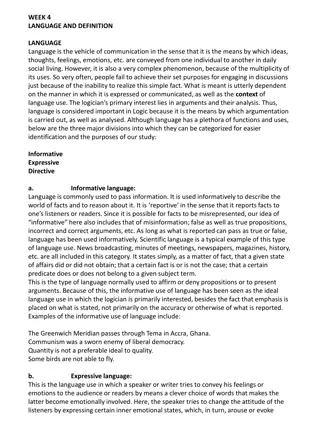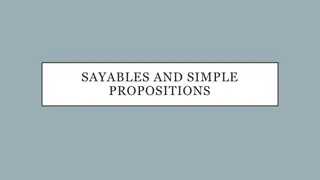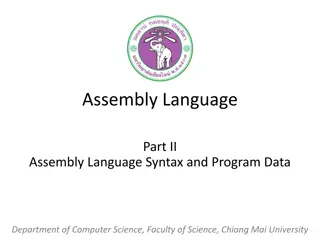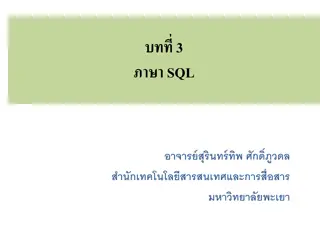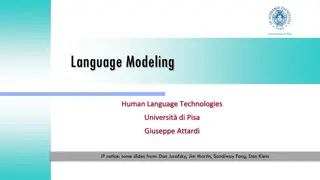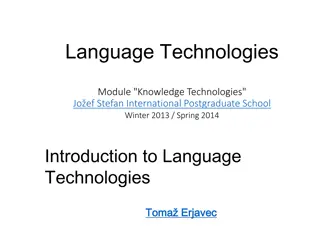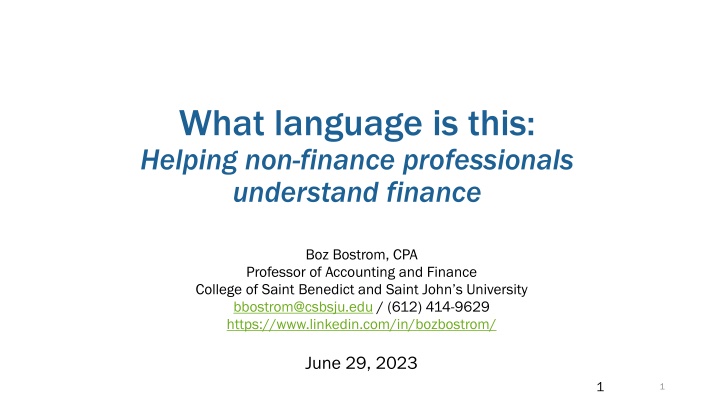
Finance for Non-Finance Professionals with Boz Bostrom, CPA
Gain insights into essential finance concepts and terms to assist non-finance professionals, presented by Boz Bostrom, a CPA and Professor of Accounting and Finance. Explore key topics such as financial statements, time value of money, performance evaluation, and strategic decision-making. Enhance your knowledge to help others understand finance better. Get ready for interactive sessions and valuable learning opportunities.
Download Presentation

Please find below an Image/Link to download the presentation.
The content on the website is provided AS IS for your information and personal use only. It may not be sold, licensed, or shared on other websites without obtaining consent from the author. If you encounter any issues during the download, it is possible that the publisher has removed the file from their server.
You are allowed to download the files provided on this website for personal or commercial use, subject to the condition that they are used lawfully. All files are the property of their respective owners.
The content on the website is provided AS IS for your information and personal use only. It may not be sold, licensed, or shared on other websites without obtaining consent from the author.
E N D
Presentation Transcript
What language is this: Helping non-finance professionals understand finance Boz Bostrom, CPA Professor of Accounting and Finance College of Saint Benedict and Saint John s University bbostrom@csbsju.edu / (612) 414-9629 https://www.linkedin.com/in/bozbostrom/ June 29, 2023 1 1
Logistics Polling questions throughout the meeting Required for CPE If you have issues answering the polling questions, please chat or email across your answer 2.0 CPE Hours in Finance (Technical) Partial credit available minimum of 1.0 hour Questions (and tips) are very welcome, submit through chat at any time Course evaluation and CPE Certificate will be emailed within a day
Learning objectives / Agenda Understand important finance concepts and terms Understand how to help non-finance professionals learn about key financial concepts 3
Overview Entity Choice Documents and Deliverables What are financial statements? The importance of time value of money Performance Evaluation Management Levers Strategic Financial Decision Making Key Terms 4
Entity choice Single Taxation X X X X Limited Easy of Liability Raising Capital X X X X Sole proprietorship LLC Partnership Corporation S-Corporation Non-profit X 6
Entity Choice Big Questions to Ask How many owners do we plan to have? What sort of financing do we need? Are we going to reinvest or distribute profits? 7
Entity Choice - General If a company does not expect to raise capital through a great number of owners, it probably wants a flow-through entity Flow-through entity Entity doesn t pay tax, owner pays tax whether or not dividends are paid Corporation (non flow-through entity) Pays tax at 21% Owners pay tax on dividends LLCs are most common Cheap and easy to form Single owner taxed like a sole proprietorship Multiple owners treated as a partnership S-Corporations Business profits not subject to FICA tax 8
Public Companies 10-K Annual report Annual letter 10-Q Quarterly report 8-K Material current events DEF 14A (Proxy) Information to inform shareholder vote 10
Private Companies and non-profits No requirement to prepare or issue financial statements Many still do Bank requirements (covenants) Employee ownership Monitoring performance Transparency (non-profits) Will prepare financial statements and have them audited 11
All Companies: Forecasts and Budgets Why would a company prepare a budget? Make objectives clear Evaluate performance Plan for cash needs or ability to spend cash Optimally, a budget for 2024 would be prepared in the 4th quarter of 2023 Best practice: Monitor and update on a monthly basis, to forecast new outcomes 12
Importance of updating budgets through forecasts Q1 100 700 -400 400 Q2 400 200 -300 300 Q3 300 200 -300 200 Q4 200 200 -300 100 Beginning Cash Balance Cash inflows Cash outflows Ending Cash Balance Q1 100 500 -400 200 Q2 200 200 -300 100 Q3 100 200 -300 0 Q4 0 200 -300 -100 Beginning Cash Balance Cash inflows Cash outflows Ending Cash Balance 13
The Big 3 Income Statement Summarizes operations for a PERIOD of time Balance Sheet Shows a company s financial position at a POINT in time Statement of Cash Flows Shows why the company s cash balance changed 17
Income Statement - Order Cost of sales (COGS) Depreciation and Amortization EBIT EBITDA Income tax expense (provision) Interest Expense Gross margin Net income Net Sales Profit before income taxes SG&A Expenses Net Sales Cost of sales (COGS) Gross margin SG&A Expenses EBITDA Depreciation and Amortization EBIT Interest Expense Profit before income taxes Income tax expense (provision) Net income 18
Income Statement Companies select which method of accounting to use Cash Revenues when cash received, expenses when cash is paid Subject to manipulation Accrual (GAAP) Required of public companies and many private companies with bank loans Hybrid Private companies do not have to use a particular method, so they may make adjustments to suit their needs 19
What is accrual based accounting (GAAP)? Companies record revenues when EARNED and expenses when INCURRED Revenues are considered earned when goods are delivered or services are performed Expenses are considered incurred When the activity happens which will cause a decrease in assets Not when cash is received or paid! 20
Accrual based accounting Example 1 : A company provides $100 worth of services in December 2023 and will get paid in January 2024. Also, as of December 31, 2023, they owe employees $60 which will be paid in January 2024 What is the impact on 2023 s net income? The company accrues revenue and accrues expense. $40 of profit How about 2024 s net income? None, the revenue and expenses were accrued in 2023 21
Accrual based accounting Example 2: A company buys $100,000 of equipment on January 1, 2023 and expects that it will last for five years. What amount of expense will it record in 2023? $100,000 / 5 = $20,000 depreciation expense per year When the company bought the equipment it deferred expenses 22
Accrual based accounting Example 3: A customer prepays the company $10 for 1 widget in April 2023. The company buys two widgets in May 2023 for $6 apiece and ships one to the customer which had prepaid. The other widget remaining in the company s inventory. What is the company s income (or loss) for April? April = $0 What is its income for May? May = $10 - $6 = $4 When the company received payment, it deferred revenue. When it bought inventory, it deferred the expense 23
Statement of Cash Flows what do you look for? 27
What should a companys cash flows look like? Growing Co. Established Co. Operating Investing Financing 28
The importance of time value of money 29
What is meant by Time value of Money? A dollar today is worth more than a dollar a year from now. Why? Inflation Interest Compounding interest When interest is reinvested, it also earns interest If someone invests $100 today at a 10% interest rate, and spends the $10 of interest each year, how much will they have earned over 30 years? $10 x 30 = $300 If someone invests $100 at a 10% interest rate and reinvests the interest each year, how much will they have earned over 30 years? $16,449 30
The impact of time value of money on business decisions Example 1: Would a company spend $100 today to earn $90 in a year? Obviously not Example 2: Would a company spend $100 today to earn $1,000 in a year? Obviously yes Example 3: Would a company spend $100 today to earn $108 in a year? Depends 31
Cost of capital (discount rate) When deciding whether to spend money today to receive money in the future, a company needs to know how much it costs them to spend the money They have to get the money from shareholders or lenders If shareholders expect a 10% return and lenders expect a 4% return (after-tax), what is the cost of capital assuming the company gets 80% of its money from shareholders and 20% from lenders? 10% x 80% + 4% x 20% = 8.8% 32
The impact of time value of money on business decisions Example 3 (again): Would a company spend $100 today to earn $108 in a year? 8% return. If cost of capital is 8.8%, they would NOT do this Example 4: Would a company spend $100 today to earn $30 per year for 4 years? If interest rates are 0%, Yes! $30 x 4 = $120 - $100 = $20 return If cost of capital is 8.8%, the $120 over 4 years is worth about $98 today, so probably not 33
Ratios and Other Performance Analysis Common size analysis Variances Growth ratios Profitability ratios Liquidity and leverage ratios Efficiency ratios Market ratios Ratios in the non-profit sector 35
Common Size Analysis The Toro Company Consolidated Statements of Earnings - $ in Thousands Oct. 31, 2019 Oct. 31, 2018 Oct. 31, 2019 Oct. 31, 2018 Net sales Cost of sales Gross profit Selling, general and administrative expense Operating earnings Interest expense Other income, net Earnings before income taxes Provision for income taxes Net earnings Basic net earnings per share of common $ 3,138,084 2,090,121 1,047,963 722,934 325,029 (28,835) 25,939 322,133 48,150 $ 273,983 $ 2.57 $ 2,618,650 1,677,639 941,011 567,926 373,085 (19,096) 18,408 372,397 100,458 $ 271,939 $ 2.56 100.0% 66.6% 33.4% 23.0% 10.4% -0.9% 0.8% 10.3% 1.5% 8.7% 100.0% 64.1% 35.9% 21.7% 14.2% -0.7% 0.7% 14.2% 3.8% 10.4%
Variances Fav (unfav) variance (320,000) $ (140,000) $ (20,000) $ 100,000 $ (380,000) $ Actual 4,680,000 $ (3,640,000) $ (520,000) $ (400,000) $ 120,000 $ Budget 5,000,000 $ (3,500,000) $ (500,000) $ (500,000) $ 500,000 $ Revenues Cost of goods sold Selling Expenses Administrative expenses Operating Income Quantity Sold Price per Unit Headcount $ 5,200 900 $ 5,000 1,000 $ 200 (100) (1) 37 9 10
Growth Ratios Net Revenues Total and same store Per employee Net income (or Earnings per share) Higher growth is generally thought of as good! Companies will generally try to grow EPS by at least 10% Through revenue growth, expense efficiency, and possibly share buybacks 38
Profitability ratios Gross margin Gross Margin / Sales Higher for companies with valuable patents or high-demand products (3M over 40%) EBITDA or EBIT (Operating) margins EBITDA or EBIT / Sales 3M has about 20% EBIT margin Profit margin Net income / Sales Toro has about 10% profit margin Return on assets, equity, investment, invested capital Net income / Assets Return on equity. Companies often target 10 15% or more Higher margins are generally thought of as good! 39
A bit about EBITDA Earnings Before Interest, Taxes, Depreciation, and Amortization One of the most popular financial metrics Represents pre-tax operating cash flows Start with EBIT (excludes interest and taxes) Addback Depreciation and amortization Valuation multiples are often based on EBITDA multiples 40
EBITDA and Private Equity Goal: Purchase a business, grow EBITDA and the multiple, then sell it. Example: Purchase for: EBITDA $1 million Multiple x 6 Valuation $6 million Sell for: $2 million x 10 $20 million 41
Liquidity Ratios Current Ratio (higher is safer) Current Assets / Current Liabilities If under 1.0, need to understand how current liabilities will be paid off Debt-Equity (higher is riskier) Debt / Equity Typical companies have 10-20% debt and 80-90% equity Interest Coverage / Leverage Ratio Operating Income / Interest Expense (higher is safer) Debt / EBITDA (higher is riskier) 42
A bit about Leverage In finance, Capital is defined as the market value of equity plus interest bearing Debt Debt often has a negative connotation, but In the Spring of 2023, a sampling of 300 of the Fortune 1000 companies shows that healthy companies have about 20% of their capital in Debt, and the other 80% in equity Even Amazon had $67 billion of debt at the end Why would companies do this? 43
A bit about Leverage: Example A company needs $1,000 of cash for a project that will return 15% after tax (so $150) Option 1: Finance with $1,000 of equity. $150 of returns / $1,000 equity = 15% returns to shareholders Option 2: Finance with $800 of equity and $200 of debt Interest rates currently about 5%. Interest payments tax deductible, so rate is about 4% after tax deduction $150 of returns before interest $200 x 4% = $8 of interest expense after tax $150 - $8 = $142 net returns / $800 equity = 17.7% return to shareholders 44
Efficiency ratios / Working Capital Asset turnover Sales / Assets Days receivable 365 / (Sales / Receivables) About 30 days Days inventories (or inventory turnover) 365 / (COGS / Inventories) Apple about 10 days, Target about 60 days, 3M about 90 days Days payables 365 / (COGS / Accounts payable) About 30 days What is good? High turnover, low days receivables and days inventories, high days payables 45
Market Value Ratios Price Earnings Ratio Market price per share / Earnings per share 20-25 for the typical company. Higher for growing companies. Examples: Lululemon, Tesla, and Chipotle all over 50 46
Ratios in the non-profit sector Change in revenues Change in contributions Change in net assets Program expenses vs. Administrative expenses 47
Good signs Warning Signs Sales increasing in volume Prices increasing Margins increasing Cash flow from operations increasing No one-time items propping up profits or cash flows Investments increasing Sales decreasing in volume Prices decreasing Margins decreasing Cash flow from operations decreasing One-time items sustaining the business Investments decreasing 48
Management levers to increase profits and cash flows Increase sales Organic growth. Quantity and price Acquisitions Decrease expenses Fixed. Headcount, facilities, advertising Variable. Sourcing of products Optimize borrowing (capital structure) Line of Credit. Only causes interest expense when utilized Decrease income taxes 50








